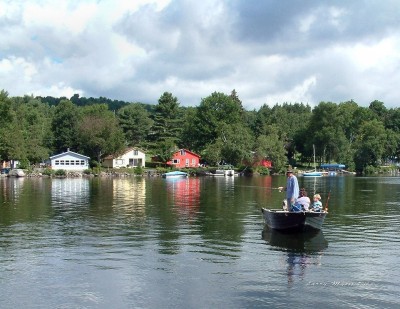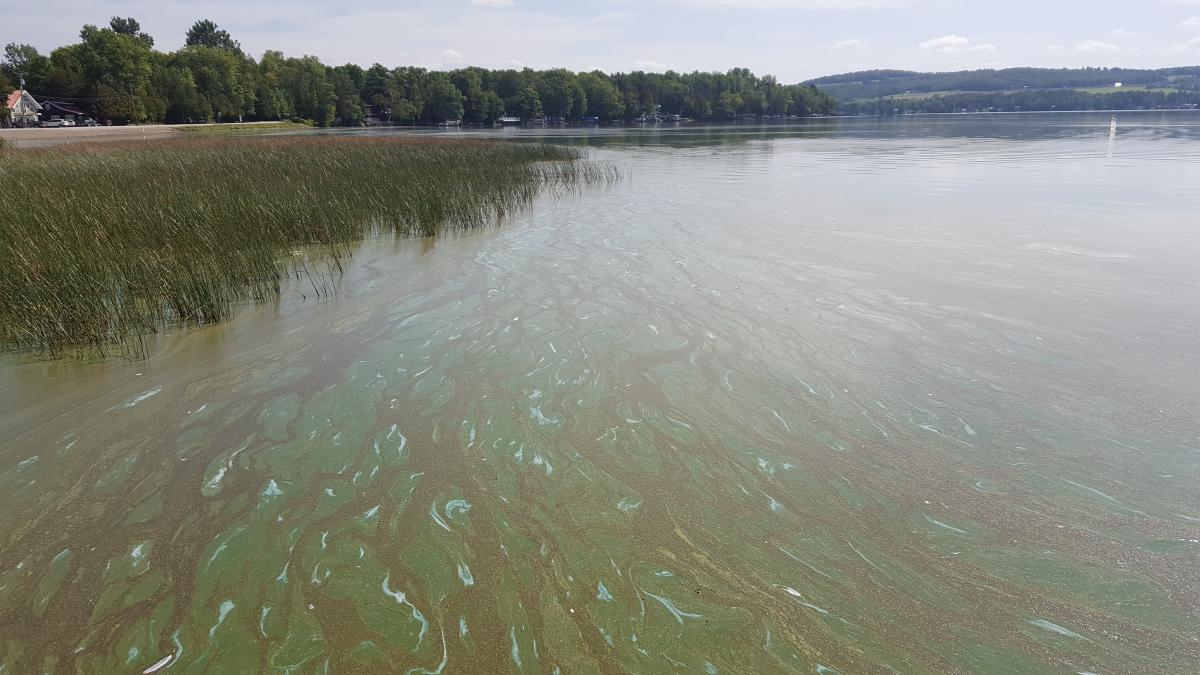
With a 1375-acre surface area, Lake Carmi is the fourth largest natural lake located entirely within Vermont. It is 7.5 miles around, averaging about 20 feet in depth, and is 33 feet at its deepest point. The lake supports northern pike, walleyes, and other warm water species. The lake drains north into Quebec’s Pike River, then into Lake Champlain. Lake Carmi was once much larger. In the thousands of years since the last ice age, the southern end of the original lake has silted in, creating wetland forests and the third largest peat bog in Vermont. Nestled among hills in the town of Franklin, less than a one-hour drive northeast of Burlington, the lake is a popular destination for anglers, birders, boaters, and campers. Lake Carmi State Park offers 173 campsites as well as a boat launch, day-use picnic area, swimming beach, and walking trails.
Water Quality Concerns
High phosphorus concentrations in Lake Carmi have resulted in water quality problems for several decades. Late summer algae blooms, reduced water clarity, and heavy aquatic plant growth have persisted. In 2008, the Department of Environmental Conservation listed Lake Carmi as “impaired” for phosphorus. The impaired label means that the lake does not meet Vermont Water Quality Standards. In other words, the total amount of phosphorus observed in Lake Carmi is higher than what should be observed in Lake Carmi.
Section 303(d) of the U.S. Clean Water Act requires waters that do not meet state water quality standards to have a “Total Maximum Daily Load,” or TMDL analysis prepared. A “TMDL” identifies a daily amount (“load”) of phosphorus that can enter the lake without causing water quality problems. A TMDL identifies where phosphorus inputs are coming from and how much of a reduction of those inputs are needed in order to restore water quality to a waterbody.
In 2009, the Environmental Protection Agency (EPA) approved a TMDL to manage phosphorus concentrations in Lake Carmi. The Vermont Agency of Natural Resources and Agency of Agriculture have worked together with the Franklin Watershed Committee and other partners to reduce nonpoint sources of phosphorus in the watershed.
Water Quality Management
Watershed Management
Significant effort has been devoted to reducing the phosphorus inputs into Lake Carmi from multiple sources within the watershed. The Vermont Agency of Agriculture, Food & Markets has worked with the agricultural community to install best management practices to reduce phosphorus runoff, including practices like manure injection, cover crop installation, and reduced tillage. Erosion reduction practices have been installed along private roads and culverts to prevent phosphorus-laden sediments from entering surface waters. Homeowners around the lake have participated in voluntary Lake Wise practices, including planting vegetation along the shoreline and managing stormwater runoff from development to reduce phosphorus inputs. Lake Carmi State Park has installed a “zero discharge wastewater treatment system,” to better manage waste and prevent phosphorus from entering Lake Carmi.
The amazing efforts of all sectors are seen in the monitoring data. By 2021, the phosphorus reductions from agricultural practices alone exceeded the reduction targets outlined in the TMDL. Despite the ongoing work in the watershed to reduce phosphorus inputs into Lake Carmi, algae and cyanobacteria blooms in the lake continue to persist in summer and fall. These blooms mainly continue due to the presence of legacy phosphorus in the lake sediments, which can cause “internal phosphorus loading.” Legacy phosphorus sits on lake and riverbeds, deposited years ago, and can feed algae blooms when the sediments get naturally stirred up. This causes a lag time between when projects are implemented and when improvements are seen in a waterbody.
Because of the persistent algae blooms that occur in Lake Carmi and their associated health risks, in-lake management techniques were used and are proposed to mange water quality in Lake Carmi.
Aeration
In 2019, an aeration system was installed in Lake Carmi, with the goal of reducing internal phosphorus to prevent algae blooms. The aeration system was designed to prevent thermal stratification in the lake, which would result in increased oxygen in bottom waters and the oxidation of iron and manganese compounds in the bottom water. This change in conditions causes phosphorus to stay immobilized in the lakebed sediments. If the phosphorus stays in the sediments, it wont move into the water column and contribute to the formation of cyanobacteria blooms.
The aeration system did not meet the goals of the project. When the system was running, it was usually able to remove thermal stratification in the water column, introducing at least some dissolved oxygen down to the deep waters and maintaining concentrations above 2 ug/L at 9 m depth, which was the project target. However, the system was not able to effectively reduce surface water phosphorus concentrations or cyanobacteria blooms and seems to have had the opposite effect. Therefore, the aeration system was not operated in 2024, and removal is planned for 2025.
Proposed Alum Treatment
In 2024, a comprehensive feasibility study was conducted by Barr Engineering to evaluate the expected water quality benefits and costs of an in-lake aluminum treatment to control internal phosphorus loading in Lake Carmi. When alum (aluminum sulfate) is added to a lake, phosphate is removed in the water column through precipitation forming a floc that settles to the lake bottom. This floc layer forms a barrier to internal phosphorus loading from the sediment. For more information on alum, the North American Lake Management Society has a webpage on The Use of Alum for Lake Management, including a position statement that "alum is a safe and effective lake management tool."
There has been extensive research done during the course of the aeration period and the years immediately preceding, including work by DEC staff, UVM researchers, and Barr Engineering (as part of the alum feasibility study). This work has included regular field sampling by DEC staff, and ongoing work by the Lay Monitoring Program and the Cyanobacteria Monitoring Programs. It also includes deployment of an automated profiling buoy (by UVM) as well as extensive additional research by UVM students including sediment geochemical analyses, phytoplankton taxonomy, and satellite image analysis.
This page serves as a central location for information about monitoring and management of Lake Carmi’s water quality, with emphasis on actions in the watershed and in-lake processes.

